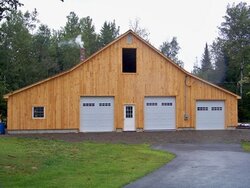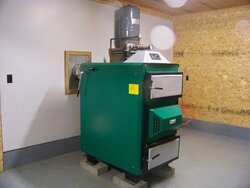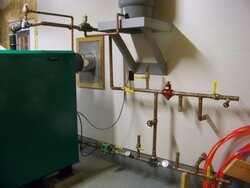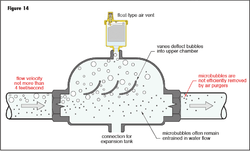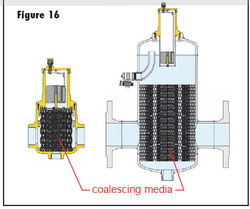Had my first real fire today to see if I'm on track to stay warm this winter. I think it'll take me a little time to learn to burn.....lots of trips to the shop to check the fire.
Looking for a little advice on a few things:
My current setup is very simple: EKO is in new shop with a 210' run of 1-1/4 pex; EKO connected in-series with oil boiler; no electrical conduit run from house to boiler; storage is planned in shop, but still I'm still looking for two LP tanks; stub-ups are there for overheat zone, but not installed; three radiant zones planned in shop, but not plumbed yet.
Questions:
-Right now, I'm using a Taco 010 at the boiler for my main circulator to feed the zone manifold in the house. The 4 house zones are fed with Taco 007's. Without wires run from shop to house, will it be possible to divert to storage (located in shop) when the house is not calling for heat?
-I used some translucent pex when connecting to my oil boiler.........I can see that there's plenty of air in the lines. Water is circulating, but the air is obvious. I included some purge valves near the oil boiler, but the air level doesn't seem to change. Suggestions?
-Finally, lots of smoke when opening the top door on the EKO. (Fans off, bottom door closed, damper open) What's the general consenus, install a hood with exhaust fan, or will I get less smoke as I gain experience burning?
Pics are attached for comments or suggestions. (Plenty of smoke out the chimney too, but I blame that on being a newbie)
Thanks,
TH
Looking for a little advice on a few things:
My current setup is very simple: EKO is in new shop with a 210' run of 1-1/4 pex; EKO connected in-series with oil boiler; no electrical conduit run from house to boiler; storage is planned in shop, but still I'm still looking for two LP tanks; stub-ups are there for overheat zone, but not installed; three radiant zones planned in shop, but not plumbed yet.
Questions:
-Right now, I'm using a Taco 010 at the boiler for my main circulator to feed the zone manifold in the house. The 4 house zones are fed with Taco 007's. Without wires run from shop to house, will it be possible to divert to storage (located in shop) when the house is not calling for heat?
-I used some translucent pex when connecting to my oil boiler.........I can see that there's plenty of air in the lines. Water is circulating, but the air is obvious. I included some purge valves near the oil boiler, but the air level doesn't seem to change. Suggestions?
-Finally, lots of smoke when opening the top door on the EKO. (Fans off, bottom door closed, damper open) What's the general consenus, install a hood with exhaust fan, or will I get less smoke as I gain experience burning?
Pics are attached for comments or suggestions. (Plenty of smoke out the chimney too, but I blame that on being a newbie)
Thanks,
TH


